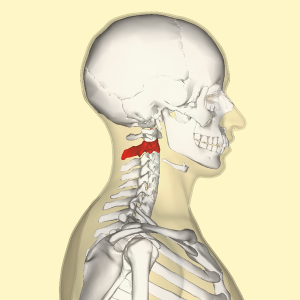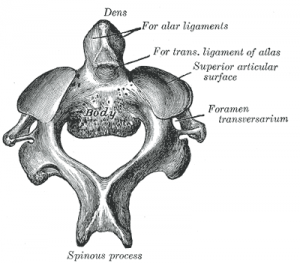Axis
Introduction[edit | edit source]
The Axis forms the pivot upon which the first cervical vertebra (the Atlas), which carries the head, rotates.
Structure[edit | edit source]
Odontoid process[edit | edit source]
The most distinctive characteristic of this bone is the strong Odontoid Process (also known as the "dens") which rises perpendicularly from the upper surface of the body. Posteriorly the Odontoid process is flattened where it articulates with the transverse ligament.
Vertebral body[edit | edit source]
The body is deeper in front than behind, and prolonged downward anteriorly so as to overlap the upper and front part of the third vertebra. It presents in front a median longitudinal ridge, separating two lateral depressions for the attachment of the Longus colli muscles. Its under surface is concave from before backward and convex from side to side.
Other Structures[edit | edit source]
The pedicles are broad and strong, especially in front, where they coalesce with the sides of the body and the root of the odontoid process. They are covered above by the superior articular surfaces.
The laminae are thick and strong, and the vertebral foramen large, but smaller than that of the atlas.
The transverse processes are very small, and each ends in a single tubercle; each is perforated by the transverse foramen, which is directed obliquely upward and laterally.
The superior articular surfaces are round, slightly convex, directed upward and laterally, and are supported on the body, pedicles, and transverse processes.
The inferior articular surfaces have the same direction as those of the other cervical vertebrae.
The superior vertebral notches are very shallow, and lie behind the articular processes; the inferior lie in front of the articular processes, as in the other cervical vertebrae.
The spinous process is large, very strong, deeply channelled on its under surface, and presents a bifid, tuberculated extremity.
Development[edit | edit source]
The axis is ossified from five primary and two secondary centres. The body and vertebral arch are ossified in the same manner as the corresponding parts in the other vertebrae, one centre for the body, and two for the vertebral arch. The centres for the arch appear about the seventh or eighth week of foetal life, while the centres for the body appear in about the fourth or fifth month. The dens or odontoid process consists originally of a continuation upward of the cartilaginous mass, in which the lower part of the body is formed. About the sixth month of life, two centres make their appearance in the base of this process: they are placed laterally, and join before birth to form a conical bilobed mass deeply cleft above; the interval between the sides of the cleft and the summit of the process is formed by a wedge-shaped piece of cartilage. The base of the process is separated from the body by a cartilaginous disk, which gradually becomes ossified at its circumference, but remains cartilaginous in its centre until advanced age. In this cartilage, rudiments of the lower epiphyseal lamella of the atlas and the upper epiphyseal lamella of the axis may sometimes be found. The apex of the odontoid process has a separate centre which appears in the second and joins about the twelfth year; this is the upper epiphyseal lamella of the atlas. In addition to these there is a secondary centre for a thin epiphyseal plate on the under surface of the body of the bone.








